Inbound marketing is a strategy designed to attract customer by providing helpful and relevant information during each stage of the customer’s buying decision so that genuine value is added. This method allows customers to discover your business via social media, blogs and search engines.
The art of inbound marketing is all about adding genuine value for the customer instead of assaulting them with heavy handed marketing messages. Customers are engaged with by providing them with high quality and authoritative content.
The opposite of outbound marketing (which bombards customers with calls to action), inbound marketing seeks to capture audiences with sincere content and encourage them to make a purchase decision without being overly intrusive.
Inbound marketing has become more popular in recent years as marketers realise that audiences are quite resilient to traditional forms of marketing. People are now using the full power of the internet to find the most authoritative business that meets their needs and inbound marketing is how you make your business appealing to this audience.

The four pillars of inbound marketing
There are four main steps in the process of inbound marketing that need to be followed for it to be effective. They are;
- Attract
- Convert
- Close
- Retain
Let’s take a look at each stage of the inbound marketing process.
Attract
The best way to attract an audience for inbound marketing is with enticing, interesting and engaging content. This is achieved by executing a content marketing strategy that uses search engine optimisation (SEO) and social media marketing principles to deliver said content to as much of the audience as possible.
Convert
Converting the audience is all about turning those readers into leads for your business. This can be accomplished via including CTA’s, forms and others means for the audience to engage with your business.
Close
The close is where you convert leads into paying customers and requires you to use a variety of sales tools to accomplish. While it can be tempting to start throwing offers at your leads, you still need to be careful with you go about it in order to foster a long-term customer relationship.
Retain
Retaining your customers after they have already engaged with your business is a key way to continue generating business down the line. Successfully retaining a customer means that they return to your business over and over again because of how you have consistently provider them with value.

